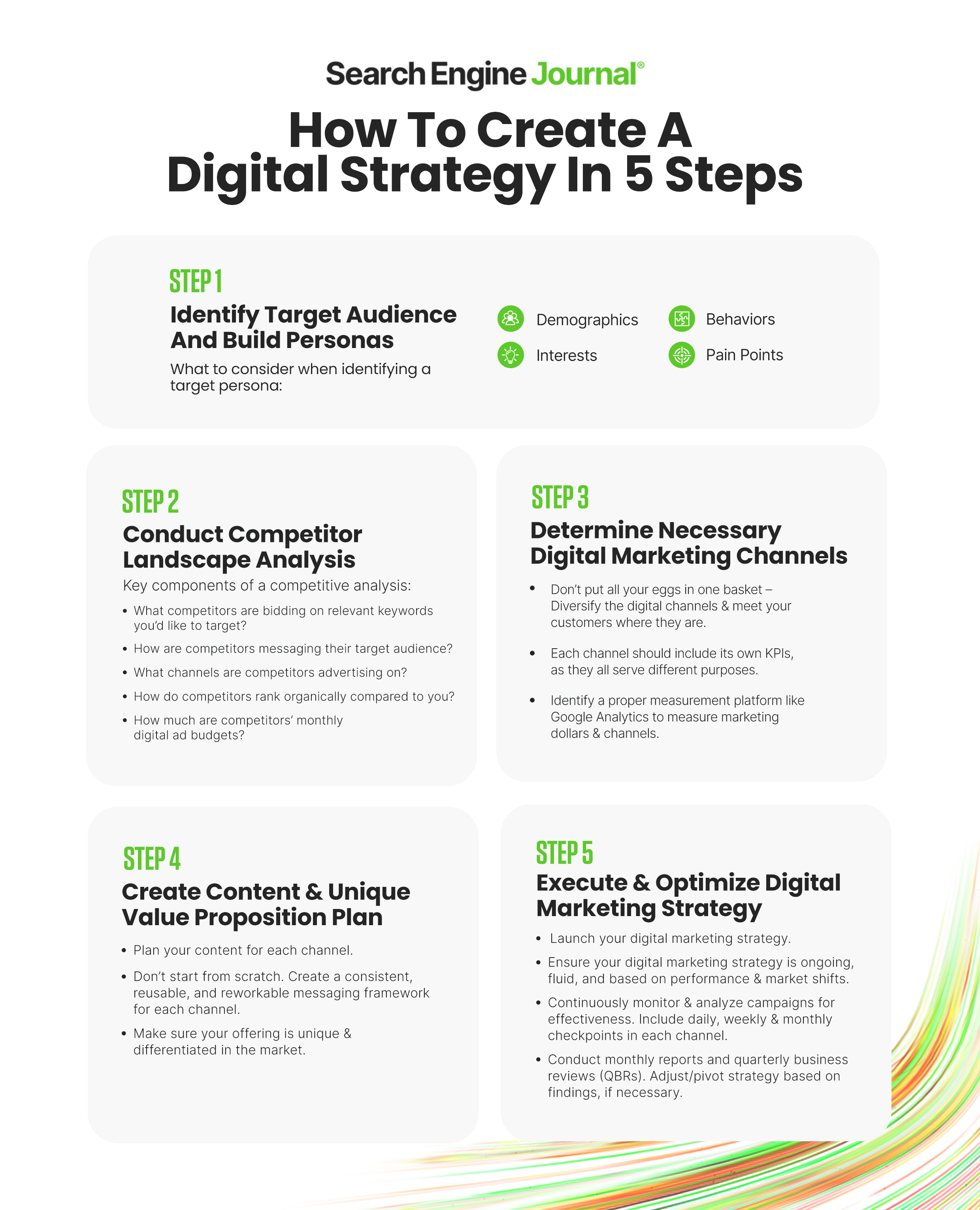How to Build a Successful Digital Marketing Strategy from Scratch
Building a digital marketing strategy can feel overwhelming. Where do you start?
How do you ensure success? Digital marketing is crucial for any business today. A well-crafted strategy can drive traffic, boost sales, and build brand awareness. But starting from scratch requires careful planning. You need to understand your audience, set clear goals, and choose the right channels.
Without a solid plan, your efforts may fall flat. This guide will walk you through the key steps. Learn how to create a strategy that aligns with your business goals and engages your target audience. Ready to dive in? Let’s get started on building a successful digital marketing strategy from scratch.

Credit: www.searchenginejournal.com
Table of Contents
Setting Goals And Objectives
Setting goals and objectives is the cornerstone of any successful digital marketing strategy. Without clear goals, you are essentially navigating without a map. Your efforts might be good, but they won’t be focused or effective.
Think about what you want to achieve. Whether it’s increasing brand awareness, driving more traffic, or generating leads, having defined goals gives your strategy direction. It also helps you measure success and make necessary adjustments.
Identifying Key Metrics
To measure the success of your goals, you need to identify key metrics. These are the numbers that will tell you if you’re on the right track.
For instance, if your goal is to increase website traffic, look at metrics like page views, unique visitors, and bounce rate. If your goal is to generate leads, track form submissions, downloads, or sign-ups.
Make sure your metrics are specific and measurable. This will make it easier to see progress and identify areas for improvement.
Defining Target Audience
Knowing who you’re targeting is crucial. Your marketing efforts will be much more effective if they’re tailored to the right audience.
Start by creating buyer personas. These are detailed profiles of your ideal customers. Include information like age, gender, interests, and buying behavior.
Use data from your current customers and market research to create these personas. The more detailed you are, the better you can tailor your strategy to meet their needs.
Remember, your target audience is not everyone. Narrowing down your audience allows you to create more focused and effective marketing campaigns.
Have you ever set a goal without knowing who you were trying to reach? How did that work out for you? Share your experiences in the comments below!
Conducting Market Research
Conducting market research is crucial for building a successful digital marketing strategy. It helps you understand your audience, competitors, and market trends. This knowledge allows you to make informed decisions and tailor your strategy to meet your goals.
Analyzing Competitors
Start by identifying your main competitors. Look at their websites, social media profiles, and online advertisements. Note their strengths and weaknesses. Analyze their content, keywords, and SEO practices. This will give you insights into what works in your industry and where you can improve.
Use tools like SEMrush or Ahrefs to gather data on your competitors’ performance. Look at their traffic sources, backlinks, and top-performing pages. Understanding their strategies can help you refine your own approach.
Understanding Market Trends
Stay updated on current market trends. Follow industry news, blogs, and reports. Identify emerging technologies, consumer behaviors, and economic factors that may impact your business. This will help you stay ahead of the curve.
Use tools like Google Trends to track search patterns and seasonal changes. Look for shifts in consumer interest and adapt your strategy accordingly. Knowing what is popular can help you create relevant content that attracts more visitors.
Engage with your audience through surveys and social media. Ask for feedback and listen to their needs. This direct interaction can provide valuable insights into their preferences and pain points.
Developing Content Strategy
Creating a digital marketing strategy involves defining goals, understanding the target audience, and selecting appropriate channels. Focus on content planning, keyword research, and consistent engagement to drive success.
Creating a robust digital marketing strategy from scratch starts with developing a content strategy. Your content is the voice of your brand and a crucial tool to engage your audience. A well-thought-out content strategy helps you attract, engage, and retain your target audience.
Creating Engaging Content
Creating engaging content is the cornerstone of your content strategy. Focus on understanding your audience’s needs and preferences. What are their pain points? What solutions can you offer them?
Use a mix of content types—blogs, videos, infographics, and social media posts. Variety keeps your audience interested.
Ensure your content is not just informative but also entertaining and relatable. Share personal experiences to make your content more authentic. For instance, I once struggled to find the right tools for my marketing campaign, but after some trial and error, I discovered tools that saved me time and money. Sharing such experiences can make your content more relatable.
Choosing Content Channels
Choosing the right content channels is as important as creating the content itself. Not all content channels will suit your brand or your audience.
Identify where your audience spends most of their time. Are they active on social media platforms like Facebook and Instagram, or do they prefer reading blogs and watching YouTube videos?
Use analytics tools to track where your audience is most engaged. This data will help you focus your efforts on the channels that provide the best return on investment.
Experiment with different channels and measure the results. If one channel isn’t working, don’t hesitate to shift your focus. Flexibility is key to a successful content strategy.
What channels have you found most effective for reaching your audience? Share your thoughts in the comments below!
Measuring And Analyzing Performance
Building a successful digital marketing strategy involves more than just setting up campaigns and hoping for the best. One of the most crucial steps is measuring and analyzing performance. This allows you to understand what works, what doesn’t, and how you can improve. Let’s dive into the specifics of using analytics tools and adjusting your strategy based on the data you collect.
Using Analytics Tools
Using analytics tools is essential to track the performance of your digital marketing efforts. Tools like Google Analytics, SEMrush, and HubSpot can provide valuable insights into how your campaigns are performing. They show you metrics like website traffic, conversion rates, and user behavior.
For instance, Google Analytics can help you see which pages on your website get the most traffic. If you notice that one blog post is particularly popular, you might want to create more content on that topic. Using these tools effectively can help you make data-driven decisions, rather than relying on guesswork.
Consider setting up custom dashboards to monitor your key performance indicators (KPIs). This can make it easier to spot trends and anomalies quickly. If you’re not familiar with setting these up, many tools offer tutorials or customer support to help you get started.
Adjusting Strategy Based On Data
Once you have the data, the next step is to adjust your strategy accordingly. If a particular ad campaign isn’t driving conversions, you might need to tweak the ad copy or target a different audience. Data can show you exactly where the problem lies, helping you make precise changes.
Imagine noticing that your email open rates are low. You could test different subject lines or send times to see what resonates best with your audience. Small adjustments based on data can lead to significant improvements over time.
Also, don’t be afraid to experiment. Try A/B testing different elements of your campaigns, such as headlines, images, or calls to action. This will help you understand what your audience prefers and optimize your strategy accordingly.
How often do you review your data and make adjustments? Regular reviews are key to staying on top of your digital marketing game. Set a schedule, whether it’s weekly or monthly, and stick to it.
In conclusion, measuring and analyzing performance is not just a one-time task. It’s an ongoing process that requires attention and action. By using analytics tools effectively and adjusting your strategy based on data, you can continually improve your digital marketing efforts and achieve better results.
Frequently Asked Questions
How To Create A Digital Marketing Strategy From Scratch?
Define your goals and target audience. Conduct a competitive analysis. Choose effective digital marketing channels. Create engaging content. Track performance and adjust strategies accordingly.
What Is The 3-3-3 Rule In Marketing?
The 3-3-3 rule in marketing focuses on delivering three key messages in three sentences within three seconds. This helps capture attention quickly and ensures clear communication.
What Are The 7 C’s Of Digital Marketing?
The 7 C’s of digital marketing are: Content, Context, Connection, Community, Convenience, Customization, and Conversion. These principles help create effective marketing strategies.
What Are The 5 C’s Of Digital Marketing?
The 5 C’s of digital marketing are Content, Customer, Context, Channel, and Conversion. These elements drive successful marketing strategies.
Conclusion
Crafting a digital marketing strategy takes time and effort. Start by setting clear goals. Understand your audience well. Create valuable, engaging content. Use social media wisely. Track your results regularly. Adjust strategies based on insights. Keep learning and stay updated with trends.
Successful strategies grow from consistent efforts. Follow these steps and your digital marketing will thrive.

